2021 MERCEDES-BENZ GLE COUPE trailer
[x] Cancel search: trailerPage 52 of 466
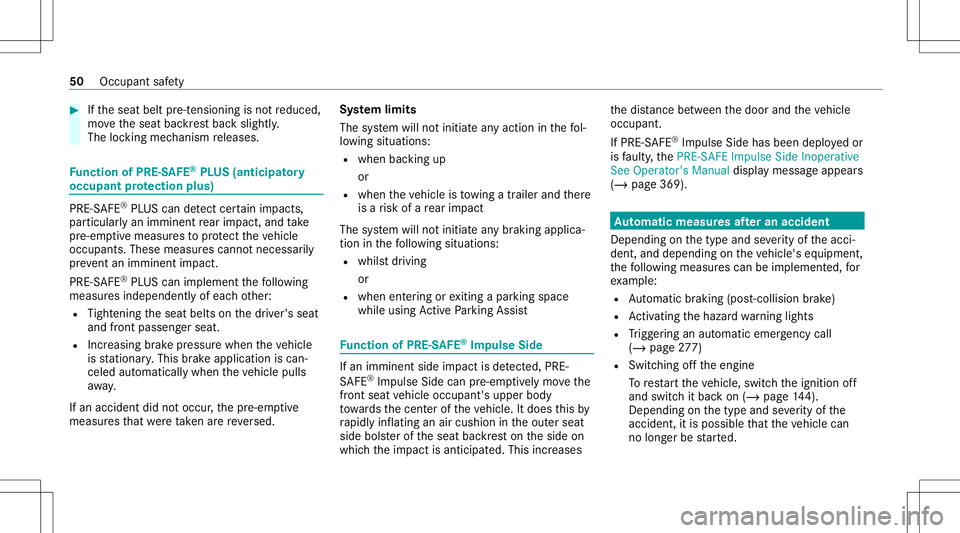
#
Ifth eseat beltpre-t ension ingisno tre duced,
mo vetheseat backres tbac kslightl y.
The locking mechanism releases. Fu
nction ofPRE-S AFE®
PL US (anticipat ory
occupant protection plus) PRE-
SAFE®
PL US can detect cer tain im pact s,
par ticular lyan imm inentrear impact ,and take
pr e-em ptive measur estoprotect theve hicle
occupants. Thesemeasur escanno tnecessar ily
pr eve ntan imm inentimpact.
PR E-S AFE ®
PL US can implem entthefo llo wing
measur esindepe ndently of eac hot her :
R Tight ening theseat belts onthedr iver's seat
and front passeng erseat.
R Increasin gbr ak epr essur ewhen theve hicle
is statio nary.This brak eapplication iscan‐
celed automaticall ywhen theve hicle pulls
aw ay.
If an accident didnotoccur ,th epr e-em ptive
measur esthat we retake nar ere ve rsed. Sy
stem limit s
The system will notinitiat ean yaction inthefo l‐
lo wing situat ions:
R when backingup
or
R when theve hicle istowing atrailer andther e
is arisk ofare ar impact
The system will notinitiat ean ybr aking applica‐
tion inthefo llo wing situat ions:
R whils tdr ivin g
or
R when entering orexitin gapar kingspace
while using ActivePa rking Assist Fu
nction ofPRE-S AFE®
Im pulse Side If
an imminen tside impact isde tected, PRE-
SA FE®
Im pulse Side canpre-emp tively movethe
fr ont seatve hicle occupant's upperbody
to wa rdsth ecent eroftheve hicle. Itdoes this by
ra pidly inflating anair cushion intheout erseat
side bolsterof theseat backres ton theside on
whic hth eim pact isantic ipated.This increases th
edis tance betwee nth edoor andtheve hicle
occupant.
If PRE-S AFE®
Im pulse Sidehasbeen deployedor
is faulty ,th ePRE-S AFEImpulse SideInoper ative
See Operator 'sManual displaymessag eappear s
(/ page369). Au
tomatic measures afte ran acciden t
Dep endingonthetype andseverity of theacci‐
dent ,and depending ontheve hicle's equipment,
th efo llo wing measur escan beimplemen ted, for
ex am ple:
R Automatic braking (post-collisi onbrak e)
R Activati ng thehazar dwa rning light s
R Trigg ering anaut omat icemer gency call
(/ page 277)
R Swi tching offth eengine
To restar tth eve hicle, switchth eignition off
and switc hit bac kon (/ page14 4).
Dependi ngon thetype andseverity of the
acc iden t,itis poss iblethat theve hicle can
no long erbe star ted. 50
Occupant safety
Page 166 of 466
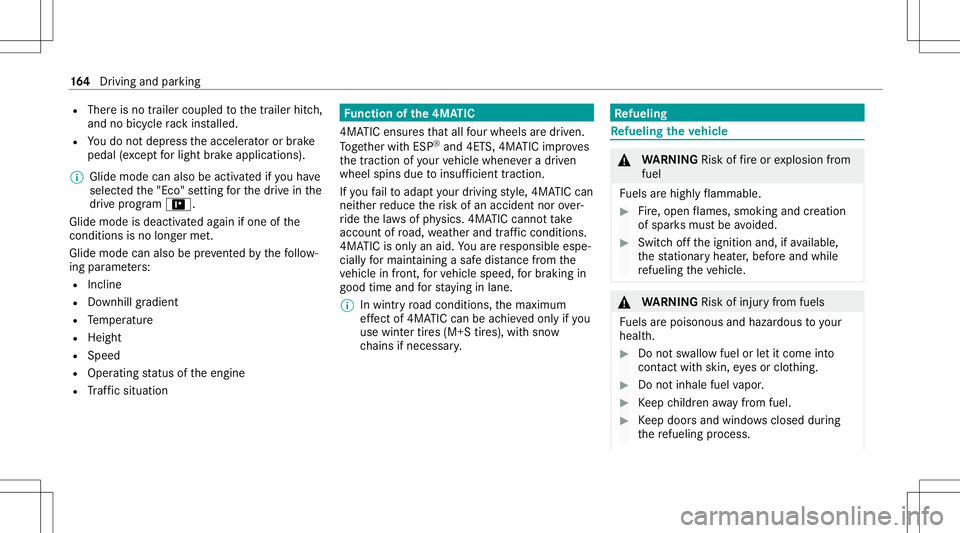
R
Ther eis no trailer coupled tothetrailer hitch,
and nobicy clerack installed.
R Youdo notdepr esstheaccelera toror brak e
peda l(e xc ep tfo rlig ht brak eapp lications).
% Glide mode canalsobe activ ated ifyo uha ve
select edthe"Eco" setting forth edr ive in the
dr ive pr og ram =.
Gli de mode isdea ctivated again ifone ofthe
condi tions isno long erme t.
Gl ide mod ecan also be preve nted bythefo llo w‐
ing parame ters:
R Incline
R Downhill gradi ent
R Temp eratur e
R Height
R Speed
R Oper ating status oftheengine
R Traf fic situ ation Fu
nction ofthe4MA TIC
4MA TICensures that all four wheel sar edr iven .
To get her withESP ®
and 4ETS,4MA TICimprove s
th etraction ofyour vehicle whene vera dr iven
whee lspins duetoinsuf ficie nttracti on.
If yo ufa ilto adap tyo ur drivin gst yle, 4MA TICcan
neit her reduce therisk ofan accident norover‐
ri de thelaws ofphysics. 4MA TICcannotta ke
acc oun tof road, weather and traf fic condi tions.
4MA TICisonly anaid. Youar ere sponsible espe‐
cially formaint ainingasaf edis tance from the
ve hicle infront, forve hicle speed, forbr aking in
good timeandforst ay ing inlane.
% Inwint ryroad con dition s,themaximum
ef fect of 4MA TICcan beachie vedonl yif yo u
use wint ertires (M+ Stir es), withsn ow
ch ains ifnec essar y. Re
fueli ng Re
fueli ngtheve hicl e &
WARNIN GRisk offire or explosion from
fuel
Fu els arehighly flammab le. #
Fire,open flames ,smo kingand creat ion
of spar ksmus tbe avo ided. #
Swit choffth eignition and,ifav ailable,
th est atio naryheat er,bef oreand while
re fuel ingtheve hicle. &
WARNIN GRisk ofinju ryfrom fuels
Fu els arepoisonous andhazar dous toyour
healt h. #
Donotsw allo wfuel orletit co me into
co ntact withsk in, eyes orclo thing. #
Donotinhale fuelvapor . #
Keep childr enaway from fuel. #
Keep door sand windo wsclos edduring
th ere fuel ingprocess. 16
4
Driving and parking
Page 181 of 466
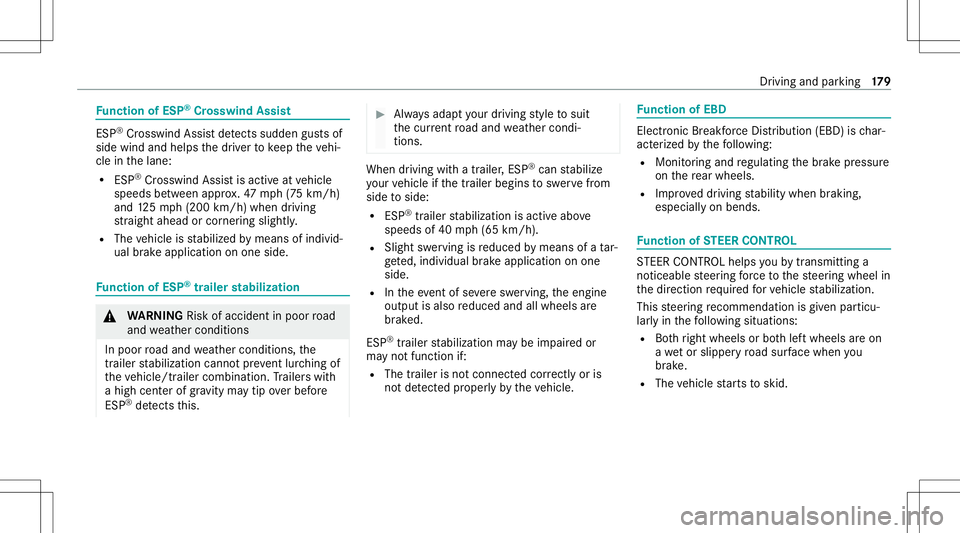
Fu
nction ofESP ®
Cr osswind Assist ES
P®
Cr osswind Assistde tects sudde ngu stsof
side wind andhelps thedr iver tokeep theve hi‐
cle inthelane:
R ESP®
Cr osswind Assistis activ eat vehicle
speeds between appr ox.47 mp h(7 5 km/h)
and 125mp h(200 km/h) whendriving
st ra ight ahead orcor ner ing slight ly.
R The vehicle isstabiliz edbymeans ofindivi d‐
ua lbr ak eapp lication onone side. Fu
nction ofESP ®
trailer stabil izatio n &
WARNIN GRisk ofacci dent inpoo rro ad
and weather condition s
In poor road and weather condition s,the
tr ai le rst abiliz ationcan notpr ev ent lurching of
th eve hicle/tr ailercombination. Trailer swit h
a high centerof grav ity ma ytip ove rbef ore
ESP ®
de tects this. #
Alw aysadap tyo ur drivin gst yle to suit
th ecur rent road and weather condi‐
tio ns. When
drivin gwit hatrailer ,ES P®
can stabiliz e
yo ur vehicle ifth etrailer begins tosw erve from
side toside:
R ESP ®
traile rst abiliz ationis act ive abo ve
speeds of40 mph(65 km/h).
R Slight swerving isreduced bymeans ofata r‐
ge ted, individual brak eapplication onone
side.
R Intheeve ntofsevere sw erving, theengine
output isalso reduced andallwheels are
br ak ed.
ES P®
tra iler stabiliz ationma ybe impair edor
ma yno tfun ction if:
R The trailer isno tcon nectedcor rectl yor is
no tde tected prope rly by theve hicle. Fu
nction ofEBD Elect
ronic Brea kfor ce Dis trib uti on (EBD) isch ar‐
act erize dby thefo llo wing:
R Mon itor ing and regulating thebr ak epr essur e
on there ar wheels .
R Improv ed driving stabilit ywhen brakin g,
espe ciallyon ben ds. Fu
nction ofSTEER CONT ROL ST
EER CONTR OLhelpsyo uby trans mitting a
no tice ablesteer ing forc eto thesteer ing wheel in
th edir ect ion requ ired forve hicle stabiliz ation.
This steer ing recomme ndation isgiv en particu‐
lar lyin thefo llo wing situat ions:
R Both right wheels orboth leftwheels areon
a we tor slip pe ry road sur face whe nyo u
br ak e.
R The vehicle star ts to skid. Dr
iving andparking 17
9
Page 195 of 466
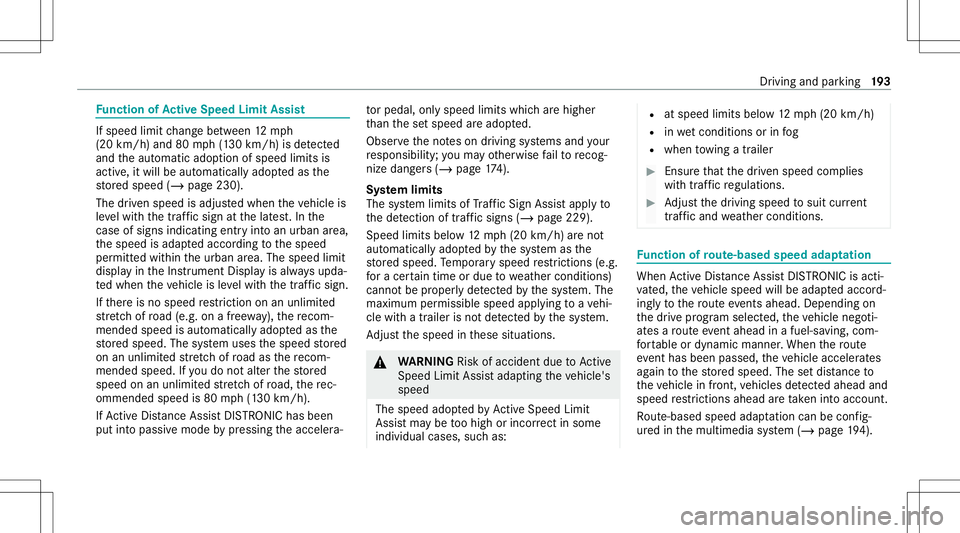
Fu
nction ofActiv eSpe edLimit Assist If
speed limitch ang ebe tween 12mp h
(20 km/ h)and 80mph(1 30 km/h) isde tected
and theaut omatic adoptionofspeed limitsis
activ e,itwill beaut omaticall yadop tedas the
st or ed speed (/page230).
The driven speed isadjus tedwhen theve hicle is
le ve lwit hth etraf fic sig nat thelat est.In the
case ofsig ns indi cati ngentr yint oan urb anarea ,
th espeed isadap tedaccor dingtothespeed
per mitt edwithin theurban area. The speed limit
displa yin theIns trument Displayis alw aysupda ‐
te dwhen theve hicle isleve lwit hth etra ffic sign .
If th er eis no speed restriction onanunlimited
st re tchof road (e.g.on afree wa y), there com‐
mend edspe edisau tomatical lyadop tedas the
st or ed speed. Thesystem uses thespeed stor ed
on anunlimit edstre tchof road asthere com‐
mend edspe ed. Ifyo udo notalt er thestor ed
speed onanunlimit edstre tchof road, there c‐
omme ndedspeedis80 mph(1 30 km/h) .
If Ac tiveDis tance AssistDIS TRONI Cha sbe en
pu tint opa ssi ve mode bypressing theaccelera ‐to
rpeda l,onl yspee dlimi tswhi charehigh er
th an these tspeed areadop ted.
Obser vetheno teson driving systems andyour
re sponsibili ty;yo uma yot her wise failto recog‐
nize dangers(/ page 174).
Sy stem limit s
The system limits ofTraf fic Sign Assistappl yto
th ede tection oftraf fic sig ns (/ page 229).
Speed limitsbel ow 12mp h(2 0km/h) areno t
au tomatical lyadop tedby thesy stem asthe
st or ed speed. Temp orar yspeed restrictions (e.g.
fo ra cer tain tim eor due towe ather condition s)
can notbe proper lyde tected bythesy stem. The
maximum permissible speedapplying toave hi‐
cle withatrailer isno tde tected bythesy stem.
Ad jus tth espeed inthese situation s. &
WARNIN GRisk ofacci dent dueto Active
Spe edLimi tAssi stadap tingth eve hicle's
speed
The speed adoptedby ActiveSpe edLimi t
Assi stma ybe toohigh orincor rect insome
indi vidualcase s,su ch as: R
atspee dlimit sbelo w12 mp h(2 0km/h)
R inwe tcond itions orinfog
R when towing atrailer #
Ensur eth at thedr iven speed complies
wit htraf fic re gulations. #
Adjus tth edr iving speed tosuit current
tr af fic and weather condition s. Fu
nction ofrout e-base dspee dadap tation When
ActiveDis tance AssistDIS TRONI Cis acti ‐
va ted, theve hicle speed willbeadap tedaccor d‐
ing lyto thero uteev ent sahead. Dependingon
th edr ive pr og ram sele cted, theve hicle negoti‐
at es aro uteeve ntaheadin afue l-saving, com ‐
fo rtable ordynam icman ner.When thero ute
eve nthasbe en passe d,theve hicle acceler ates
ag ain tothestor ed speed. Thesetdis tance to
th eve hicle infront, vehicles detected aheadand
spe edrestrictions aheadar eta ke nint oacco unt.
Ro ute-based speedadap tatio ncan beconf ig‐
ur ed inthemultimedia system (/ page19 4). Dr
iving and parking 19
3
Page 196 of 466
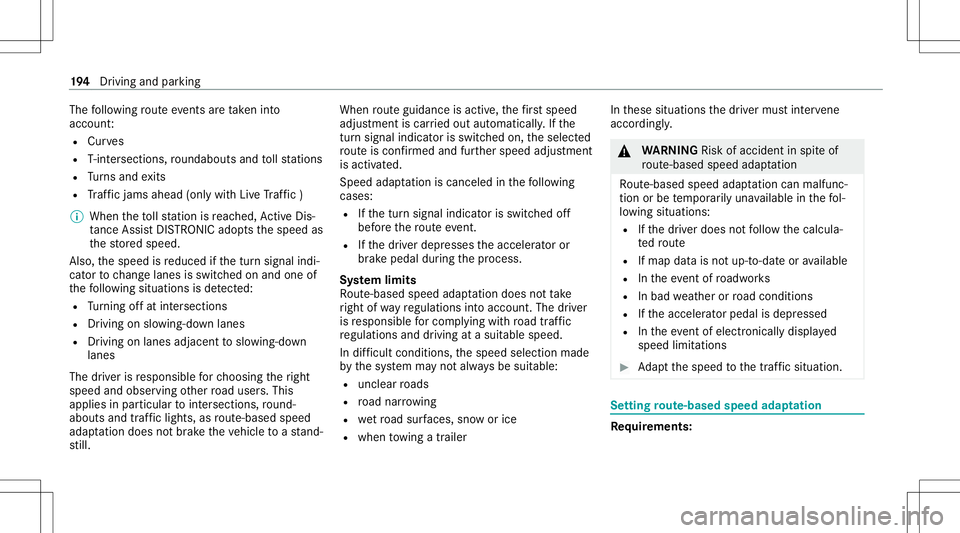
The
follo wing routeeve nts areta ke nint o
acco unt:
R Curves
R T-int ersect ions,ro und about sand tollst atio ns
R Turnsand exits
R Traf fic jams ahead(only with Liv eTr af fic )
% Whe nth eto llst atio nis reac hed, ActiveDis ‐
ta nce AssistDIS TRONI Cad op tsthespeed as
th estor ed speed.
Also, thespeed isreduced ifth etur nsignal indi‐
cat ortochang elane sis swit ched on and one of
th efo llo wing situat ionsisde tected:
R Turning offat intersect ions
R Drivin gon slowing- down lanes
R Drivin gon lanes adjacenttoslo wing-do wn
lanes
The driver isresponsible forch oosing theright
speed andobser vingother road user s.This
applies inpar ticular tointersect ions,ro und ‐
about sand traffic lights, asroute-based speed
adap tatio ndo es notbr ak eth eve hicle toast and‐
st ill. When
routeguidan ceisact ive, thefirs tsp ee d
ad jus tment iscar ried out automaticall y.Ifth e
tur nsigna lind icatoris swi tched on,theselect ed
ro uteis co nfirmed andfurther speed adjustment
is activ ated.
Speed adaptatio nis canc eled inthefo llo wing
cases :
R Ifth etur nsignal indicat orisswitc hedoff
bef oreth ero uteeve nt.
R Ifth edr iver depr esses theacceler ator or
br ak epedal during thepr ocess.
Sy stem limit s
Ro ute-based speedadap tatio ndo es notta ke
ri ght ofwa yre gulations intoaccount .The driver
is responsible forcom plying withro ad traf fic
re gulations anddriving atasuit able speed.
In dif ficul tcondi tions,th espeed selectionmade
by thesy stem mayno talw aysbe suit able:
R unclear roads
R road nar row ing
R wetro ad sur faces, snowor ice
R whe nto wing atrailer In
these situation sth edr iver mus tint erve ne
acco rding ly. &
WARNIN GRisk ofacci dent inspi teof
ro ute-based speedadap tatio n
Ro ute-based speedadap tatio ncan malfunc‐
tio nor be temp orarily una vailable inthefo l‐
lo wing situat ions:
R Ifth edr iver does notfo llo wthecalcula‐
te dro ute
R Ifmap datais no tup-t o-dat eor available
R Intheeve ntofroadw orks
R Inbad weather orroad con dition s
R Ifth eaccelera torpeda lis depr essed
R Intheeve ntofelectr onicallydispla yed
speed limitations #
Adaptth espeed tothetraf fic situ ation. Se
tting rout e-base dspee dadap tation Re
quirement s: 19
4
Driving and parking
Page 198 of 466
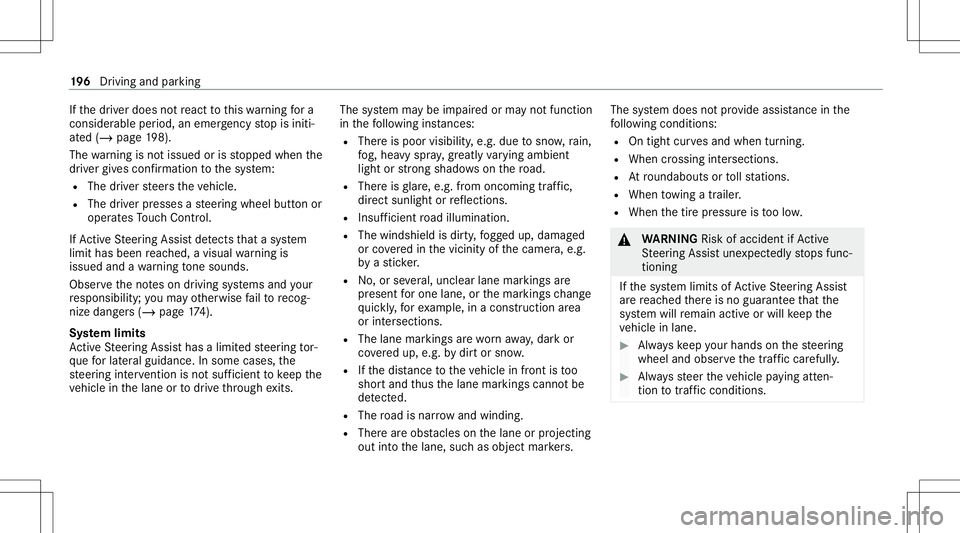
If
th edr iver does notre act tothis wa rning fora
consider ableper iod, anemerg encystop isiniti‐
at ed (/ page19 8).
The warning isno tissued orisstopped whenthe
dr iver giv es con firm atio nto thesy stem:
R The driver steer sth eve hicle.
R The driver presses ast eer ing wheel buttonor
oper ates Touc hCon trol.
If Ac tiveSt eer ing Assis tde tects that asy stem
limit hasbeen reac hed, avisual warning is
issued andawa rning tone sou nds.
Obs erve theno teson driving systems andyour
re sponsibili ty;yo uma yot her wise failto recog‐
nize dangers(/ page 174).
Sy stem limit s
Ac tiveSt eer ing Assis thas alimit edsteer ing tor‐
qu efo rlat eral gui dance. Insome cases, the
st eer ing interve ntio nis no tsu fficien tto keep the
ve hicle inthelane ortodrive th ro ugh exits. The
system maybe impair edorma yno tfunc tion
in thefo llo wing instances:
R The reispoor visibilit y,e.g. due tosno w,rain,
fo g, hea vyspr ay,gr eatl yva rying ambien t
light orstro ng sha dows onthero ad.
R Ther eis glar e, e.g .fr om oncom ingtraf fic,
di re ct sunli ght orreflect ions.
R Insuf ficie ntroad illumin ation.
R The wind shieldisdir ty,fo gg ed up, damag ed
or coveredin thevicinit yof thecamer a,e.g.
by ast icke r.
R No, orseveral,unc lear lane markingsare
pr esen tfo rone lane, orthemar king sch ang e
qu ickl y, forex am ple, inacon stru ction area
or intersecti ons.
R The lane mar kings arewornaw ay,dar kor
co veredup, e.g. bydirtor sno w.
R Ifth edis tance totheve hicle infront istoo
shor tand thus thelane marking scann otbe
de tected.
R The road isnar row and wind ing.
R Ther ear eobs tacle son thelane orprojec ting
out intoth elane, suchas objec tmar kers. The
system does notpr ov ide assis tance inthe
fo llo wing condition s:
R Ontigh tcur vesand when turning.
R When crossing intersections.
R Atround about sor tollst atio ns.
R When towing atrailer .
R When thetir epr essur eis toolow. &
WARNIN GRisk ofacci dent ifAc tive
St eer ing Assis tune xpect edlyst ops func‐
tionin g
If th esy stem limits ofActiveSt eer ing Assis t
ar ere ac hed ther eis no guar anteethat the
sy stem will remain activeor wil lke ep the
ve hicle inlane. #
Alw ayske ep your han dson thesteer ing
wheel andobser vethetra ffic car efull y. #
Alw aysst eer theve hicle paying atten‐
tion totraf fic condi tions. 19
6
Driving and parking
Page 204 of 466
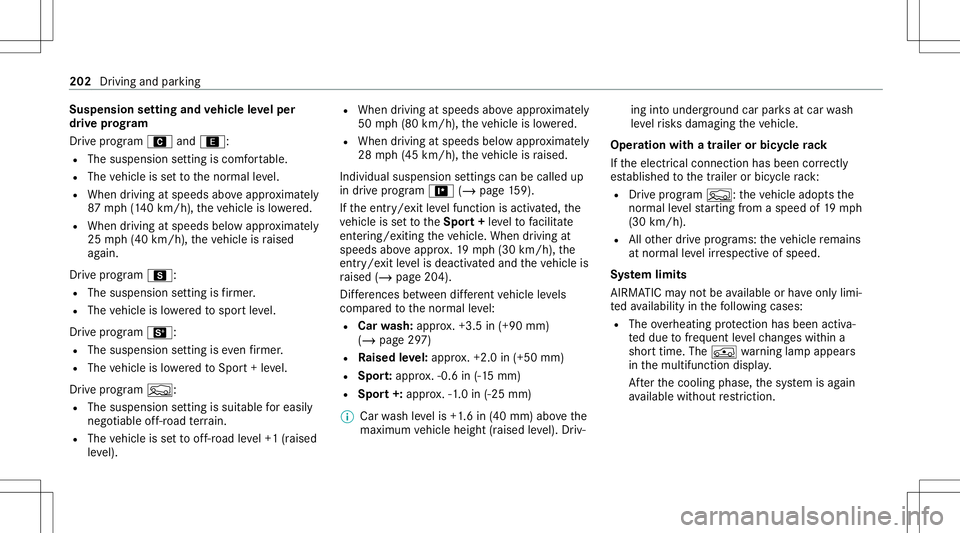
Suspension
setting andvehicl eleve lper
dr ive pr og ram
Dr ive pr ogr am A and;:
R The susp ens ion se tting iscomf ortable.
R The vehicle issetto thenor mal leve l.
R When drivin gat speeds aboveappr oximat ely
87 mph(1 40 km/h) ,th eve hicle islowe red.
R When driving atspeeds belowappr oximat ely
25 mph(40 km/h), theve hicle israised
ag ain.
Dr ive pr og ram C:
R The susp ension setting isfirm er.
R The vehicle islowe redto spor tle ve l.
Dr ive pr ogr am B:
R The suspen sionsetting iseve nfirm er.
R The vehicle islowe redto Spor t+ leve l.
Dr ive pr ogr am F:
R The suspen sionsetting issuit able foreasi ly
nego tiable of f-r oa dte rrain.
R The vehicle issetto off-r oad leve l+1 (raised
le ve l). R
When drivin gat speeds aboveappr oximat ely
50 mph(80 km/h), theve hicle islowe red.
R When driving atspeeds belowappr oximat ely
28 mph(45 km/h), theve hicle israised.
Ind ividual suspen sionsettings canbecalled up
in drive pr og ram = (/page15 9).
If th eent ry/e xit leve lfunc tion isact ivat ed, the
ve hicle issetto theSpor t+ leve lto facil itat e
ent ering/e xiting theve hicle. When driving at
speeds aboveappr ox.19 mp h(3 0km/h), the
ent ry/e xit leve lis deact ivat ed and theve hicle is
ra ised (/page204 ).
Dif fere nces betwee ndiffer ent vehicle leve ls
com paredtothenor mal leve l:
R Car wash: appr ox.+3.5 in(+90 mm)
(/ page 297)
R Raised leve l:appr ox.+2.0 in(+50 mm)
R Spo rt:ap prox .-0.6 in(-1 5mm)
R Spo rt+: appr ox.-1 .0 in(-25 mm)
% Carwa sh leve lis +1 .6 in(40 mm) abovethe
maximu mvehicle height (raised leve l). Driv‐ ing
intounder ground carparksatcar wash
le ve lri sk sdamagi ngtheve hicle.
Oper ation withatrailer orbicy clerack
If th eelectr icalconnect ionhas been correctly
es tablished tothetra iler orbicy clerack :
R Drive pr ogr am F: theve hicle adoptsthe
nor malle ve lst ar tin gfrom aspee dof 19 mp h
(30 km/ h).
R Allother drive pr ogr ams: theve hicle remains
at nor mal leve lir re spectiv eof speed.
Sy stem limit s
AI RMA TICmayno tbe available orhave onl ylimi‐
te dav ailabilit yin thefo llo wing cases :
R The overheating protect ion has been activa‐
te ddue tofreq uent leve lch ang eswit hin a
shor ttim e.The 00C4 warning lam pappear s
in themultifunc tiondispla y.
Af terth ecooling phase,thesy stem isag ain
av ailable without restriction. 202
Driving and parking
Page 206 of 466
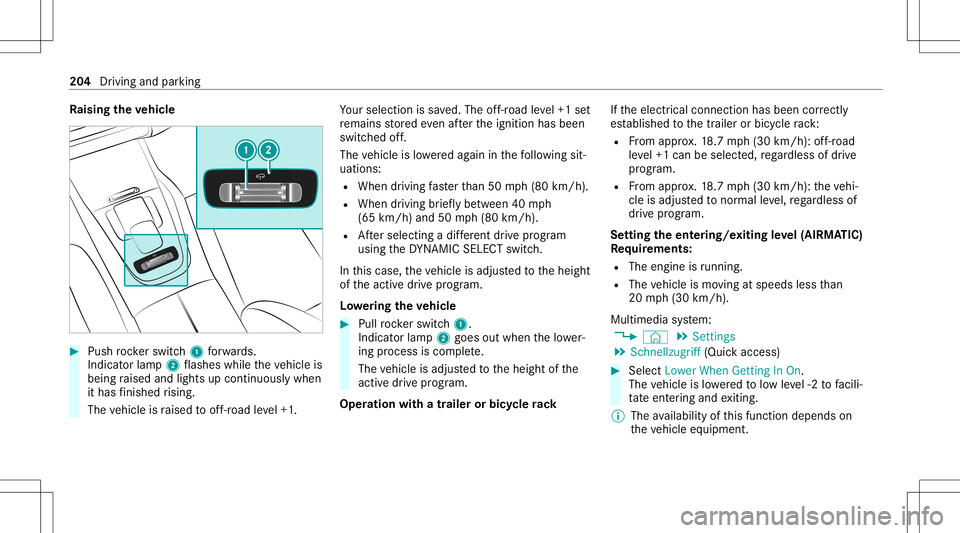
Ra
ising theve hicl e #
Push rock er switc h1 forw ards.
In dicat orlam p2 flashes whiletheve hicle is
being raised andlight sup con tinuousl ywhen
it has finis hed rising.
The vehicle israised tooff-r oad leve l+1 . Yo
ur sele ction issave d. The off-r oad leve l+1 set
re mains stor ed eve naf te rth eignition hasbeen
switc hedoff.
The vehicle islowe redag ain inthefo llo wing sit‐
uation s:
R When drivin gfa ster than 50 mph(80 km/h).
R When driving brief lybe tween 40mph
(65 km/ h)and 50mph(80 km/h).
R Aftersele cting adif fere nt drive pr ogr am
us ing theDY NA MIC SELE CTswitc h.
In this case, theve hicle isadjus tedto theheight
of theactiv edr ive pr og ram.
Lo we ring theve hicl e #
Pullro ck er switc h1.
Indic ator lam p2 goes outwhen thelowe r‐
ing process iscom plete.
The vehicle isadjus tedto theheight ofthe
act ive dr ive pr ogram.
Oper ation withatrailer orbicy clerack If
th eelectr icalconnect ionhas been correctly
es tablished tothetra iler orbicy clerack :
R From appr ox.18 .7 mp h(3 0km/h): off-r oad
le ve l+1 can beselec ted, rega rdless ofdrive
pr ogr am.
R From appr ox.18 .7 mp h(3 0km/h): theve hi‐
cle isadjus tedto nor malle ve l,re ga rdless of
dr ive pr og ram.
Se tting theent ering/e xiting leve l(AIRMA TIC)
Re quirement s:
R The engin eis running .
R The vehicle ismo ving atspeeds lessthan
20 mph(30 km/h).
Multimedia system:
4 © 5
Set ting s
5 Sch nellzugrif f(Quic kaccess) #
Select LowerWhenGettingIn On .
The vehicle islowe redto low leve l-2 tofacil i‐
ta te ent ering and exitin g.
% The availabilit yof this func tion depen dson
th eve hicle equipment. 20
4
Driving andparking